The five corrupt pillars of climate change denial
Posted on 24 December 2019 by Guest Author
This is a re-post from The Conversation by Professor of Earth System Science, UCL
The fossil fuel industry, political lobbyists, media moguls and individuals have spent the past 30 years sowing doubt about the reality of climate change - where none exists. The latest estimate is that the world’s five largest publicly-owned oil and gas companies spend about US$200 million a year on lobbying to control, delay or block binding climate policy.
Their hold on the public seems to be waning. Two recent polls suggested over 75% of Americans think humans are causing climate change. School climate strikes, Extinction Rebellion protests, national governments declaring a climate emergency, improved media coverage of climate change and an increasing number of extreme weather events have all contributed to this shift. There also seems to be a renewed optimism that we can deal with the crisis.
But this means lobbying has changed, now employing more subtle and more vicious approaches – what has been termed as “climate sadism”. It is used to mock young people going on climate protests and to ridicule Greta Thunberg, a 16-year-old young woman with Asperger’s, who is simply telling the scientific truth.
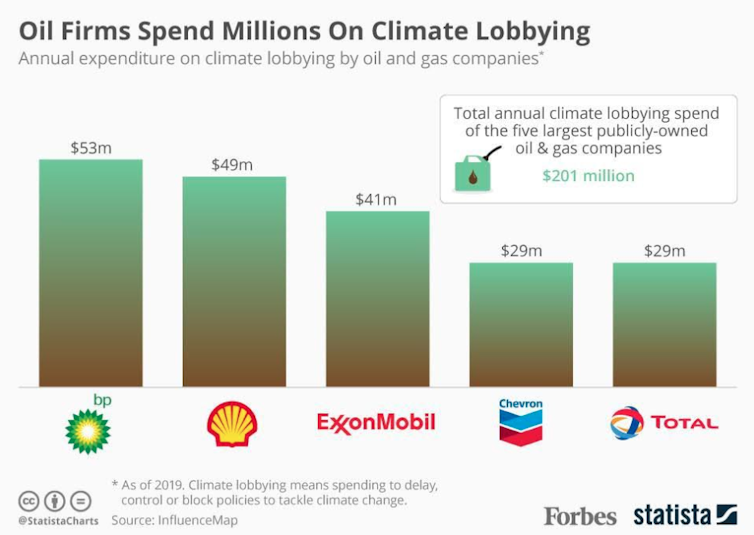 Anti-climate change lobbying spend by the five largest publicly-owned fossil fuel companies. Statista, CC BY-SA
Anti-climate change lobbying spend by the five largest publicly-owned fossil fuel companies. Statista, CC BY-SA
At such a crossroads, it is important to be able to identify the different types of denial. The below taxonomy will help you spot the different ways that are being used to convince you to delay action on climate change.
1. Science denial
This is the type of denial we are all familiar with: that the science of climate change is not settled. Deniers suggest climate change is just part of the natural cycle. Or that climate models are unreliable and too sensitive to carbon dioxide.
Some even suggest that CO? is such a small part of the atmosphere it cannot have a large heating affect. Or that climate scientists are fixing the data to show the climate is changing (a global conspiracy that would take thousands of scientists in more than a 100 countries to pull off).
All these arguments are false and there is a clear consensus among scientists about the causes of climate change. The climate models that predict global temperature rises have remained very similar over the last 30 years despite the huge increase in complexity, showing it is a robust outcome of the science.
Read more: Five climate change science misconceptions – debunked
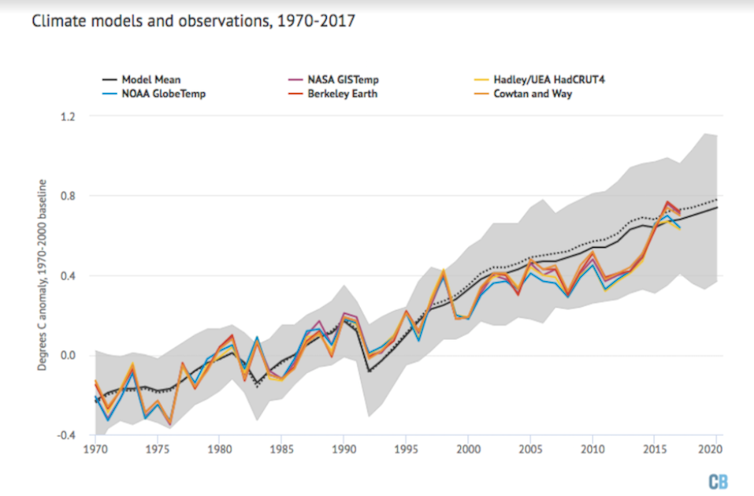 Model reconstruction of global temperature since 1970. Average of the models in black with model range in grey compared to observational temperature records from NASA, NOAA, HadCRUT, Cowtan and Way, and Berkeley Earth. Carbon Brief, CC BY
Model reconstruction of global temperature since 1970. Average of the models in black with model range in grey compared to observational temperature records from NASA, NOAA, HadCRUT, Cowtan and Way, and Berkeley Earth. Carbon Brief, CC BY
The shift in public opinion means that undermining the science will increasingly have little or no effect. So climate change deniers are switching to new tactics. One of Britain’s leading deniers, Nigel Lawson, the former UK chancellor, now agrees that humans are causing climate change, despite having founded the sceptic Global Warming Policy Foundation in 2009.
It says it is “open-minded on the contested science of global warming, [but] is deeply concerned about the costs and other implications of many of the policies currently being advocated”. In other words, climate change is now about the cost not the science.
2. Economic denial
The idea that climate change is too expensive to fix is a more subtle form of climate denial. Economists, however, suggest we could fix climate change now by spending 1% of world GDP. Perhaps even less if the cost savings from improved human health and expansion of the global green economy are taken into account. But if we don’t act now, by 2050 it could cost over 20% of world GDP.
We should also remember that in 2018 the world generated US$86,000,000,000,000 and every year this World GDP grows by 3.5%. So setting aside just 1% to deal with climate change would make little overall difference and would save the world a huge amount of money. What the climate change deniers also forget to tell you is that they are protecting a fossil fuel industry that receives US$5.2 trillion in annual subsidies – which includes subsidised supply costs, tax breaks and environmental costs. This amounts to 6% of world GDP.
The International Monetary Fund estimates that efficient fossil fuel pricing would lower global carbon emissions by 28%, fossil fuel air pollution deaths by 46%, and increase government revenue by 3.8% of the country’s GDP.
3. Humanitarian denial
Climate change deniers also argue that climate change is good for us. They suggest longer, warmer summers in the temperate zone will make farming more productive. These gains, however, are often offset by the drier summers and increased frequency of heatwaves in those same areas. For example, the 2010 “Moscow” heatwave killed 11,000 people, devastated the Russian wheat harvest and increased global food prices.
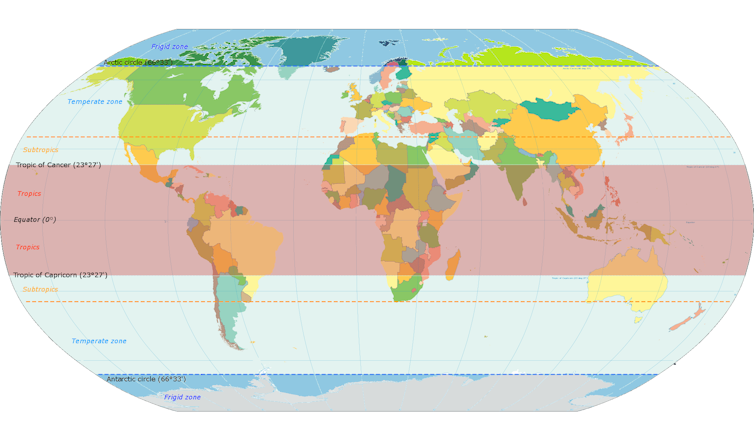 Geographical zones of the world. The tropical zones span from the Tropic of Cancer in the North to the Tropic of Capricorn in the South (red shaded region) and contains 40% of the World population. Maulucioni/Wikipedia, CC BY-SA
Geographical zones of the world. The tropical zones span from the Tropic of Cancer in the North to the Tropic of Capricorn in the South (red shaded region) and contains 40% of the World population. Maulucioni/Wikipedia, CC BY-SA
More than 40% of the world’s population also lives in the Tropics – where from both a human health prospective and an increase in desertification no one wants summer temperatures to rise.
Deniers also point out that plants need atmospheric carbon dioxide to grow so having more of it acts like a fertiliser. This is indeed true and the land biosphere has been absorbing about a quarter of our carbon dioxide pollution every year. Another quarter of our emissions is absorbed by the oceans. But losing massive areas of natural vegetation through deforestation and changes in land use completely nullifies this minor fertilisation effect.
Climate change deniers will tell you that more people die of the cold than heat, so warmer winters will be a good thing. This is deeply misleading. Vulnerable people die of the cold because of poor housing and not being able to afford to heat their homes. Society, not climate, kills them.
This argument is also factually incorrect. In the US, for example, heat-related deaths are four times higher than cold-related ones. This may even be an underestimate as many heat-related deaths are recorded by cause of death such as heart failure, stroke, or respiratory failure, all of which are exacerbated by excessive heat.
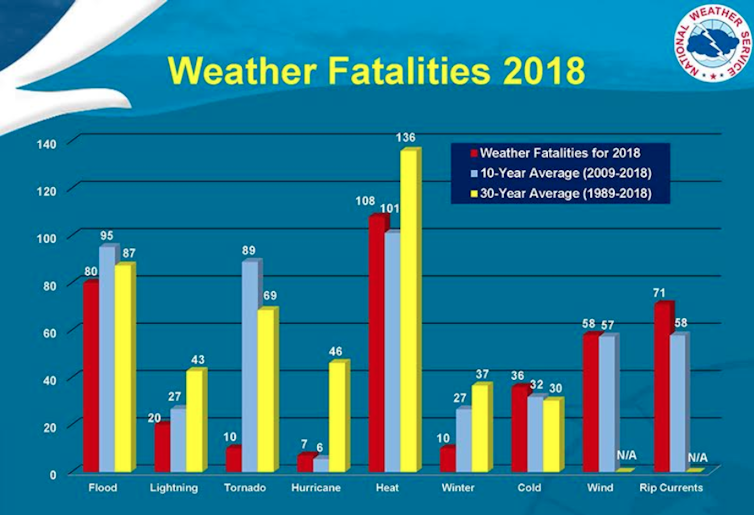 US weather fatalities for 2018 alongside the ten- and 30-year average. National Weather Service, CC BY
US weather fatalities for 2018 alongside the ten- and 30-year average. National Weather Service, CC BY
4. Political denial
Climate change deniers argue we cannot take action because other countries are not taking action. But not all countries are equally guilty of causing current climate change. For example, 25% of the human-produced CO? in the atmosphere is generated by the US, another 22% is produced by the EU. Africa produces just under 5%.
Given the historic legacy of greenhouse gas pollution, developed countries have an ethical responsibility to lead the way in cutting emissions. But ultimately, all countries need to act because if we want to minimise the effects of climate change then the world must go carbon zero by 2050.
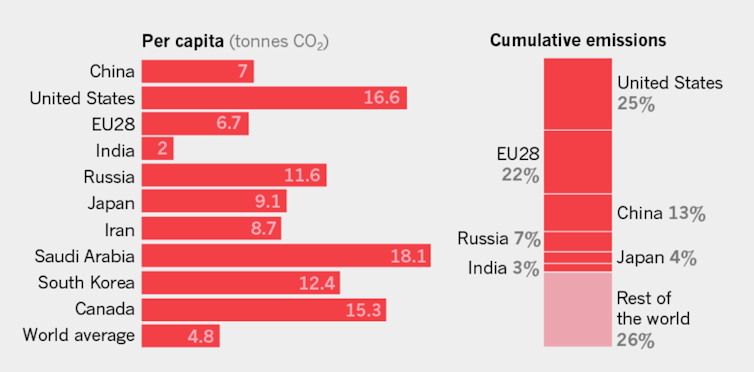 Per capita annual carbon dioxide emissions and cumulative country emissions. Data from the Global Carbon Project. Nature. Data from the Global Carbon Project
Per capita annual carbon dioxide emissions and cumulative country emissions. Data from the Global Carbon Project. Nature. Data from the Global Carbon Project
Deniers will also tell you that there are problems to fix closer to home without bothering with global issues. But many of the solutions to climate change are win-win and will improve the lives of normal people. Switching to renewable energy and electric vehicles, for example, reduces air pollution, which improves people’s overall health.
Developing a green economy provides economic benefits and creates jobs. Improving the environment and reforestation provides protection from extreme weather events and can in turn improve food and water security.
5. Crisis denial
The final piece of climate change denial is the argument that we should not rush into changing things, especially given the uncertainty raised by the other four areas of denial above. Deniers argue that climate change is not as bad as scientists make out. We will be much richer in the future and better able to fix climate change. They also play on our emotions as many of us don’t like change and can feel we are living in the best of times – especially if we are richer or in power.
But similarly hollow arguments were used in the past to delay ending slavery, granting the vote to women, ending colonial rule, ending segregation, decriminalising homosexuality, bolstering worker’s rights and environmental regulations, allowing same sex marriages and banning smoking.
The fundamental question is why are we allowing the people with the most privilege and power to convince us to delay saving our planet from climate change?































 Arguments
Arguments






























"All these arguments are false and there is a clear consensus among scientists about the causes of climate change. The climate models that predict global temperature rises have remained very similar over the last 30 years despite the huge increase in complexity, showing it is a robust outcome of the science."
The models are not robust at all between about 2000-2015, but have been recalibrated because of the heating hiatus during this time. This is far from settled science, but only a handful of "real" climatologists not self proclaimed climate scientists even understand climate modeling correctly.
The fast majority of scientists and I would assume public knows that is warming and CO2 has some influence, but it’s the warming cause is not understood entirely and therefore model predictions may be erroneous.
The following links took me 30min of researching:
https://link.springer.com/article/10.1007%2Fs00704-018-2387-7
Quantifying the importance of interannual, interdecadal and multidecadal climate natural variabilities in the modulation of global warming rates.
https://link.springer.com/article/10.1007/s00382-019-04955-2?shared-article-renderer#ref-CR12
Author: Essentially, this work emphasizes the vital role of natural variability in changing the local linear trends which represent the warming rates of corresponding periods. Our results imply that to rightly attribute the climate change and accurately forecast future climate, more attention should be paid to various quasi-periodic natural variabilities, particularly ones at interannual, interdecadal and multidecadal scales. Of upmost importance, the key points to improve the simulation and prediction skills of climate models lie in correctly distinguishing the true anthropogenic warming from natural variability and accurately simulating the phase, period and amplitude of important natural variability, in which the phase is particularly important. Unfortunately, even the state-of-the-art CMIP5 models still confuse the natural climate variability and the anthropogenic warming trend and show low skills for natural variability simulations, which is the primary cause that they fail to simulate the recent global warming hiatus (Wei and Qiao 2017).
Models are not missing something or are they?:
Evidence that global evapotranspiration makes a substantial contribution to the global atmospheric temperature slowdown
https://link.springer.com/article/10.1007%2Fs00704-018-2387-7
A greening world enhances the surface-air temperature difference
https://www.sciencedirect.com/science/article/pii/S0048969718350733?via%3Dihub
Climate is measured over a minimum of 30 years. This ddefinition was arrived at in 1934 by the IMO.
This is due to the internal variables - the natural cycles - t hat were already known of back then.
Just because we do not know everything, does not mean we know nothing.
Science advances incrementally, and the recalibration of the models so they can project shorter poeriods both globally and locally is an example of progress, not uncertainty.
All the best.
blub @1
"The models are not robust at all between about 2000-2015, but have been recalibrated because of the heating hiatus during this time. This is far from settled science, but only a handful of "real" climatologists not self proclaimed climate scientists even understand climate modeling correctly."
Adding a few things. Climate models can never be 100% robust over short time frames of about 15 years, because these timeframes are modulated by ocean variability, and this does not follow a completely regular cycle. For blubs information, you cant ever accurately predict something that is partly random. Climate models are intended to model long terms trends of 30 years and more, and do this well. Scientists are aware of natural variability and the very first IPCC reports stated there would be flat periods within a longer term warming trend. The slowdown after 1998 was such a flat period.
Blub claims models have been recalibrated, but provides no evidence of this.
Blubs claims about a handful of so called real climate scientists are totally unsubstantiated arm waving.
Regarding the rest of his screed on natural variability. Cherrypicking a couple of scientific papers does not demonstrate anything. Nothing is provided to show there has been wide acceptance of these specific papers, and they do not falsify any of the models.
Models do reproduce ocean cycles, although not perfectly. However models have proven to have good accuracy at predicting multiple trends including temperatures here and here. Clearly although ocean cycles are not perfectly understood, their affects are overwhelmed by CO2.
The graph in the OP clearly shows that temps in the 2000-2015 periods were well within the range of the models. They are now exactly falling on the ensemble mean. As noted by Nigel, blub does not provide details or substantiation of the alleged "recalibration." The link in the OP figure, however, is very informative as to the refinement of the models over time, well worth reading:
https://www.carbonbrief.org/qa-how-do-climate-models-work
Excellent presentation of the current state of affairs.
In "5. Crisis Denial" I would add an additional point regarding the denier claim that "We will be much richer in the future and better able to fix climate change."
The global economy will only be able to be better (richer) in the future if it becomes substantially comprised of Sustainable Activity, the sooner the better. Any perceptions of wealth, or poverty reduction, that rely on fossil fuels will fail to continue into the future.
blub:
"The models are not robust at all between about 2000-2015"
Didn't you mean 1998-2012? In any case, you are cherry-picking. Why did you not comment on the entire record? Is it because the entire record shows that the models are indeed robust. At the very least, because of natural cycles, you have to look at a minimum 30 year intervals in order to see the signal from the noise. By picking 1998-2012, you are looking at the noise, not the signal, which is obvious if you look at the entire record.
"but have been recalibrated because of the heating hiatus"
No, there is no evidence for any recalibration at all between 1998 and 2012. If you disagree please show your evidence and your references.
"This is far from settled science"
When we say "settled science" we don't mean every detail is settled, only that certain details are settled. And "settled" means that "the vast majority of climate scientists agree that an assessemnt of all the evidence leads to this conclusion". As examples: CO2 is increasing, global tempertures are increasing, anthropogenic sources are almost entirely responsible for the increase in CO2, adverse overall climate consequences are already happening and will get worse especially if we go above 1.5 degrees C. This is all "settled science".
"only a handful of "real" climatologists..even understand climate modeling correctly".
There are not just a "handful" of "real" climatologists who understand climate modeling correctly, and those who do agree that the models are robust. As in every field there are contrarians, and those with fringe on climate science who disagree.
The rest of your comment consists, likewise, of cherry-picked links. This is not how science is done. All the papers and all the evidence must be taken into account. This is what the IPCC does and you should avail yourself of the conclusions contained in their reports or distilled by reputable science communicators.
I think we spend too much time and effort on "blub" style comments. I suggest responding to such material with the words: "unnecessary to comment". In my climate class, " impact of an outlaw species" , I always have a denier or two. Their question is usually, " what can you say that would change my mind about climate change?" My answer is "nothing", followed by my moving on with the lecture. Most of them get up and leave the room to those who want to know.
The post is a concise description of the areas of climate change denial with some good, hard facts to counter those points. However, the refutation of Economic Denial is exceedingly weak. When will people stop mis-citing the Stern Report? Yes, it said that "cutting carbon emissions so that carbon dioxide peaked in the range of 450-550 parts per million would cost 1 percent of the GDP annually".
BUT, this report was produced 13 YEARS ago! Things are much, much worse now. Also, 550ppm CO2 is itself a catastrophic level.
So the cheery pep-talk about it taking only 1% of world GDP is hogwash.
No question that the vested interests of Oil, Gas and Coal are spending huge amounts of money lobbying but not only on lobbying. The also spend huge amounts of money supporting the election campaigns of politicians world wide, often on both sides of the political spectrum just to hedge their bets. As such there is a simple, effective, hugely necessary measure we must take to address this and a whole raft of other problems that beset us. It is dead simple. Who Pays the Piper Calls the Tune. https://mtkass.blogspot.com/2018/01/wasted-effort.html
rayates55 @8 says "Yes, it (The Stern Report) said that "cutting carbon emissions so that carbon dioxide peaked in the range of 450-550 parts per million would cost 1 percent of the GDP annually". BUT, this report was produced 13 YEARS ago! Things are much, much worse now. Also, 550ppm CO2 is itself a catastrophic level."
The Stern Report is about the costs and speed to replace fossil fuel electricity grids with renewable energy grids and so on. From memory it was based on getting to net zero by 2050, and so costs 1% per year to do that based on a period of about 44 years, and this is now shortened to 31 years, so your 1% number becomes something like 1.5% each year.
1.5% per year is still an achievable number. This is only 1.5% of global economic output each year. Its about what a typical family spends on treat foods and luxuries each year, its about what countries spend on their military, its much less than what is spent on education or healthcare. And it would be easy to find 1.5% of gdp without loss of living standards just by making some efficiencies - if we wanted.
I agree things are worse now than Stern anticipated, so double the 1.5% number if you want. This is realistic and is still doable.
Check my maths and assumptions etc, maybe its wrong, but no arm waving please. Provide details.
The article really does cover the denialist talking points very thoroughly. They are the same points used to try to rubbish other environmental science and mitigation ideas whether related to clean water, vehicle exhaust emissions, industrial waste etc. I see them all daily in our newspapers.
They reflect an attitide that short term profit must come first. This is a weakness of the capitalist system, and can only be properly mitigated with government regulation and penlties, or other devices like carbon taxes.
https://www.forbes.com/sites/niallmccarthy/2019/03/25/oil-and-gas-giants-spend-millions-lobbying-to-block-climate-change-policies-infographic/#3fb08487c4fb. This article provides no breakdown or facts to support the claim "US$200 million a year on lobbying to control, delay or block binding climate policy" and so its not possible to tell if the money was spent on what it claimed, but lets take that at face value and presume that all that money is spent lobbying to stop climate change policies.
Lets look at the other side for comparison to see how much is spent on anti hydrocarbon or towards "Green" policies. https://www.scientificamerican.com/article/clean-energy-firms-lobby-congess-as-much-as-dirty-firms-do/. So there is as much money spent on lobbying for green businesses as against them, but lets ignore that.
The US government spend of $79 billion since 1989 on policies related to climate change, including science and technology research, administration, education campaigns, foreign aid, and tax breaks http://scienceandpublicpolicy.org/images/stories/papers/originals/climate_money.pdf.
Michael Bloomberg alone is spending $500 million directly on green lobbying https://www.nytimes.com/2019/06/06/climate/bloomberg-climate-pledge-coal.html.
The liberal foundations that give targeted grants to Big Green operations have well over $100 billion at their disposal. That figure is confirmed in the Foundation Center database of the Top 100 Foundations. But how much actually gets to environmental groups? The Giving USA Institute’s annual reports show $80,427,810,000 (more than $80 billion) in giving to environmental recipients from 2000 to 2012.
The U.S. Chamber of Commerce and found $147.3 million in assets while environmental donor Gordon E. and Betty I. Moore Foundation posted $5.2 billion.
Under President Obama, government agencies have poured tens of millions into non-profit groups for anti-hydrocarbon campaigns.
So lets compare expenditure on green lobbying and support over say a 12 year figure where there are figures - Oil lobby @ $200 mill/year, government funding of $79 billion over 30 years = $2.6 billion/year and green lobbying money $80 billion over 12 years = $6.67 billion/year. So the green lobbying groups are expending $9.3 billion/year on average vs oil and gas $0.2 billion/year, or over 40 times more. That does not count the non-monetary assistance of mass media in propagating climate crisis claims, and education campaigns to indoctrinate children into green think whose value would be many billions more in influence, but even on a basic expenditure analysis who has more influence? The green policies with government backing have conservatively 40 times more influence.
BeeKing @12, "So lets compare expenditure on green lobbying and support over say a 12 year figure where there are figures - Oil lobby @ $200 mill/year, government funding of $79 billion over 30 years = $2.6 billion/year and green lobbying money $80 billion over 12 years = $6.67 billion/year."
Blatantly misleading maths. There are other words for it as well. Your oil lobby figure of $200 mill per yr is genuine lobbying money, and by no means all of it, while your $6.7 billion per year green money includes a whole lot of other stuff according to the information you provide, so education, tax breaks, research etcetera. This is not lobbying money. This is not comparing apples and oranges.
Under President Obama, government agencies have poured tens of millions into non-profit groups for anti-hydrocarbon campaigns.
No link provided to substantiate this.
Meant to say its like comparing apples and oranges.
nigelj @10 says "The Stern Report is about the costs and speed to replace fossil fuel electricity grids with renewable energy grids and so on. From memory it was based on getting to net zero by 2050, and so costs 1% per year to do that based on a period of about 44 years, and this is now shortened to 31 years, so your 1% number becomes something like 1.5% each year."
I think your projection of 1.5% each year in much too optimistic. It is not simply a linear progression, it is more like compounded debt and, in addition, the starting point is now much worse. Here are some other numbers to factor in: Since the Stern Report, we have added about 500 billion tons of CO2. We are now emitting CO2 at a rate 23% higher than in 2006, so we have to drop it by that much just to get to square one of the Stern Report, and if that took 10 years (a miracle) we would be starting 25 years too late.
The atmospheric CO2 level was 380 in 2006 and is now 408. The rate of increase is rising. The earth has 15% more people on it. The goal in Stern was 450-550ppm. But that middle value, 500ppm, that is now recognized as a catastrophic level. Feedback loops are better understood now and are expected to accelerate the rates well before 500ppm.
If we are "ballparking" here I would guess it would take at least 5% GDP per year starting now. For the U.S. that's about a trillion a year. And guess what? We are not going to do that next year, or the year after, or the year after that. By 2022 we will have 28 years left, not 31 and the starting point will be still worse.
rayates55 @15
"I think your projection of 1.5% each year in much too optimistic. It is not simply a linear progression, it is more like compounded debt and, in addition, the starting point is now much worse............If we are "ballparking" here I would guess it would take at least 5% GDP per year starting now. For the U.S. that's about a trillion a year. And guess what? We are not going to do that next year, or the year after, or the year after that. By 2022 we will have 28 years left, not 31 and the starting point will be still worse."
I don't understand why you refer to that 1.5 % of gdp number. I went on to say in my previous comment that "I agree things are worse now than Stern anticipated, so double the 1.5% number if you want. " I mean with respect I have a lot of trouble understanding how you didn't read that. So I did consider that things are worse now, however you are overdoing it a bit. For example I'm sure Stern was fully aware we could be emitting at higher rates now and that population would definitely increase, etcetera, and he would have taken that much into account.
Now my numbers of 3% of gdp were based on the Paris goal of 2 degrees by 2050, and I think I'm being very realistic. There is talk of targetting 1.5 degrees, then the time frame narrows much more, and 5% of gdp might be realistic. However its still doable if theres a will. America spent far more on the war effort in WW2.
Not once have you said anything optimistic, or how we could overcome these problems. It just leads me to think you are basically deliberately spreading negativity to discourage progress, so a form of concern trolling. Until your attitude and commentary changes a lot, that will be my conclusion.
nigelj @16 wrote: "Not once have you said anything optimistic, or how we could overcome these problems. It just leads me to think you are basically deliberately spreading negativity to discourage progress, so a form of concern trolling."
Ah yes, the retreat to insults in the face of facts. You did not address many of the facts that I presented and that you had asked for. You are correct that I said nothing optimistic. That is because I see no reason for naive optimism such as yours. You are correct that I presented no solution to these problems, that is because I know of none. Neither do you.
[DB] Sloganeering snipped.
rayates55 @17
"You did not address many of the facts that I presented and that you had asked for."
I addressed most of them, and I'm not obliged to respond to all of your comments. Some were good, some were irrelevant.
"You are correct that I presented no solution to these problems, that is because I know of none. Neither do you."
There are plenty of obvious solutions. Start changing your lifestyle, there will be things you can do that won't hurt and will probably even leave you financially better off. I'm not going to write lists, these things are easily googled.
Lobby your local politicians, I've done this on various matters not just the climate issue and if you are skillful it can make a difference. Vote for politicians and political parties that prioritise the environment. Educate your kids. It all adds up. Things eventually reach a critical mass. Policies change and history shows this. Nothing naieve about this.
rayates55 @17, putting it another way, Stern is an economist and he cannot take a climate change trend, and a deteriorating climate trend, and compounding CO2 trends and turn that into a mitigation cost, obviously. You can only say if things are deteriorating more than anticipated, it may be prudent to aim to get to net zero emissions more quickly. The time frame is a matter for climate science.
My understanding is he took the recommendation to keep warming under 2 degrees so about 40 years to get to net zero emissions, so arrived at costs of 1 % gdp year. We havent done much the past ten years, so now only have 30 years so its about 1.5% gdp year. If we aim for 1.5 degrees as per the recent IPCC recommendation, that leaves about 15 years, so about 2 - 3% gdp year. This does not suggest case of why it would be more than 5% a year.